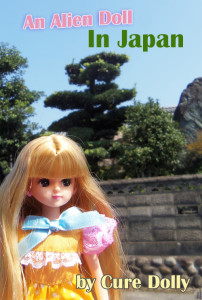 Cure Dolly’s book based on her first experiences of Japan has been published, just as the Doll herself returns to Japan.
Cure Dolly’s book based on her first experiences of Japan has been published, just as the Doll herself returns to Japan.
You can read her current adventures, in Japanese, here but if you would like to read about her first adventures, in English, you should get this book.
It is only available in a Kindle edition because color printing still makes books prohibitively expensive and this book is full of color photographs.
For Japanese learners, An Alien Doll in Japan is a fascinating record of getting by in Japan with no English at all after one year of studying by what gets called the Dolly Method.
For Cure Dolly fans, of course, the book is a must. We reproduce the publisher’s introduction:
A Doll’s-Eye View of Japan
An Alien Doll in Japan is a unique look at Japan by the well-known Japanese language blogger Cure Dolly, who assures us that she really is a doll even though she can pass for human “on a rainy night or when people are seeing what they expect rather than what they see”.
However you take her, it is clear that Cure Dolly has very little Western-Earthling enculturation and so comes to Japan with a perspective that is neither Japanese nor, in any of the usual senses, gaijin.
Her “Doll’s Eye View” of Japan is unlike anything else you may have read. This book, lavishly illustrated with color photographs, covers her first month in Aichi Prefecture.
She photographs and writes about such things as Shinto shrines and maid cafés, but also about sides of Japan that are less often seen, ranging from family life and a day in pre-school, observing the enculturation of very young Japanese children, to wanderings in Japanese countryside and small city environments, observing everything with the passion and freshness of a doll to whom human culture as a whole is something strange and new.
At the time of going to Japan, Cure Dolly had been learning (she would probably reject the term “studying”) Japanese for about a year, using the self-immersion methods she advocates. She put her theories into practice by adopting the challenge of using no language other than Japanese during the whole of her stay, even in emergencies (of which there were several).
Cure Dolly’s aim was not only to live in Japan but to live in the language she has often declared that she is “in love with”.
Being a doll rather than a regular human, there are many occasions in which her inability to negotiate ordinary situations lead to results which seem funny only in retrospect. As she says, her newness in the language was in a way her best friend, since it served as an apparent reason for her difficulty with everyday human situations.
The book is full of intense love for all the things she sees and thoughtful, but often entirely unexpected, reflections on everything from infant education to cosplay, from uniforms to Japanese Denny’s.
As Cure Dolly says in her introduction:
When I left Japan, for the first time in my life, I experienced culture shock. Japan is not my home. I am not Japanese. I am sure I was almost as strange to the Japanese as I am to anyone else. And they were strange to me. But not as strange.
Seeing an airport full of gaikokujin, I was overwhelmed by the strangeness I had seen around me ever since I came to life. It has never become less strange to me. But after Japan it seemed even more strange.
Which is a rather negative way of presenting my experience. But perhaps it clarifies it a tiny bit.
I want to try to show you Japan through my eyes.
This is Japan as you have never seen it before!
Buy it now through Amazon: An Alien Doll in Japan